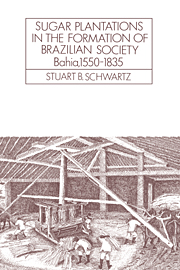Book contents
- Frontmatter
- Contents
- List of figures, maps, and tables
- Preface
- Abbreviations and special terms
- Weights and measures
- Dedication
- Part I Formations, 1500–1600
- Part II The Bahian engenhos and their world
- Part III Sugar society
- Part IV Reorientation and persistence, 1750–1835
- 15 Resurgence
- 16 The structure of Bahian slaveholding
- 17 Important occasions: the war to end Bahian slavery
- Appendixes
- Notes
- Glossary
- Sources and selected bibliography
- Sources of figures
- Index
- CAMBRIDGE LATIN AMERICAN STUDIES IN PRINT
16 - The structure of Bahian slaveholding
Published online by Cambridge University Press: 05 May 2010
- Frontmatter
- Contents
- List of figures, maps, and tables
- Preface
- Abbreviations and special terms
- Weights and measures
- Dedication
- Part I Formations, 1500–1600
- Part II The Bahian engenhos and their world
- Part III Sugar society
- Part IV Reorientation and persistence, 1750–1835
- 15 Resurgence
- 16 The structure of Bahian slaveholding
- 17 Important occasions: the war to end Bahian slavery
- Appendixes
- Notes
- Glossary
- Sources and selected bibliography
- Sources of figures
- Index
- CAMBRIDGE LATIN AMERICAN STUDIES IN PRINT
Summary
It is proof of extreme poverty to not own a slave; they may have every domestic inconvenience, but a slave at any cost.
Domingos Vandelli (Bahia, 1781)The resurgence of the sugar economy in the last decades of the eighteenth century and the first decades of the nineteenth accompanied an intensification of the traditional patterns of Bahian slave society among both masters and slaves. Increased demand for laborers called for high levels of slave imports, exacerbating the demographic structure of slavery while intensifying the African cultural presence among the slaves. This presence and a general increase in slave resistance generated fears and insecurity among the slaveholders, but they were also distracted to some extent by their own growing sense of identity as Brazilians and the preoccupations of colonial politics. Still, the threat and danger created by slave revolts moved colonial administrators to take extraordinary measures: In September 1816, the count of Arcos, governor of Bahia, ordered a census of all slaveowners in the Recôncavo to determine the size and location of the servile population. This action did little to stem the tide of rebellion, as we shall see in Chapter 17, but it does present us with an opportunity to examine the structure and significance of slaveholding in the Recôncavo at the close of the colonial era. Once done, we can compare this structure with that of other American slave regimes and then suggest how slavery and property in slaves determined the way Bahia faced its future as part of an independent nation.
- Type
- Chapter
- Information
- Sugar Plantations in the Formation of Brazilian SocietyBahia, 1550–1835, pp. 439 - 467Publisher: Cambridge University PressPrint publication year: 1986



